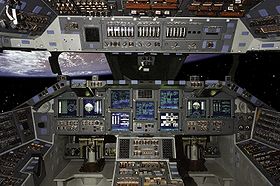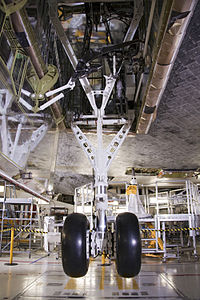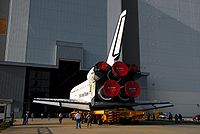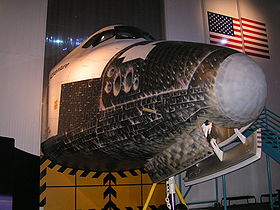- Space Shuttle orbiter
-
Space Shuttle orbiter 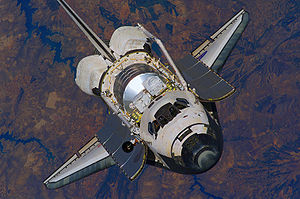
The Discovery orbiter approaches the ISS on STS-121Operator NASA Mission type Orbiter Satellite of Earth Launch vehicle Space Shuttle Solid Rocket Booster Launch site Kennedy Space Center Homepage Space Shuttle Home The Space Shuttle orbiter was the orbital spacecraft of the Space Shuttle program operated by NASA, the space agency of the United States.[1] The orbiter was a reusable winged "space-plane", a mixture of rockets, spacecraft, and aircraft. This space-plane could carry crews and payloads into low Earth orbit, perform on-orbit operations, then re-enter the atmosphere and land as a glider, returning its crew and any on-board payload to the Earth.
A total of six Orbiters were built for flight: Atlantis, Challenger, Columbia, Discovery, Endeavour and Enterprise. All were built by the Pittsburgh, PA based Rockwell International company. The first Orbiter to fly, Enterprise, took its maiden flight in 1977. Built solely for unpowered atmospheric test flights and landings, its take-off was from the back of a modified Boeing-747 cargo plane, the Shuttle Carrier Aircraft, while the remaining Orbiters were built for orbital space flights, launched vertically as part of the full Space Shuttle package. Enterprise was partially disassembled and retired after completion of critical testing.
Columbia was the first Orbiter to launch into space as a Space Shuttle, in 1981. The first launches of Challenger, Discovery, and finally Atlantis, followed in 1983, 1984 and 1985 respectively. In 1986, Challenger was destroyed in an accident after launch. Endeavour was built as Challenger's replacement, and was first launched in 1992. In 2003, Columbia was destroyed during re-entry, leaving just three remaining Orbiters. Discovery completed its final flight on March 9, 2011, and Endeavour completed its final flight on June 1, 2011. Atlantis completed the last ever Shuttle flight, STS-135, on July 21, 2011.
In addition to their crews and payloads, the reusable Orbiter carried most of the Space Shuttle System's liquid-fueled rocket propulsion system, but both the liquid hydrogen fuel and the liquid oxygen oxidizer for its three main rocket engines were fed from an external cryogenic propellant tank, and there were also two reusable large solid-fueled rocket boosters that helped to lift both the Orbiter and its external propellant tanks during approximately the first two minutes of its ascent into outer space.
Contents
Description
Attitude control system
The Space Shuttle Orbiter resembled an aircraft in its design, with a standard-looking fuselage and two double-delta wings, both swept at an angle of 81 degrees at their inner leading edges and 45 degrees at their outer leading edges. The vertical stabilizer of the Orbiter had a leading edge that was swept back at a 45-degree angle. There were four elevons mounted at the trailing edges of the delta wings, and the combination rudder and speed brake was attached at the trailing edge of the vertical stabilizer. These, along with a movable body flap, controlled the Orbiter during later stages of descent through the atmosphere and landing.
Overall, the Space Shuttle Orbiter was roughly the same size as a McDonnell Douglas DC-9 airliner.
The Reaction Control System (RCS) was composed of 44 small liquid-fueled rocket thrusters and their very sophisticated computerized (fly-by-wire) flight control system, which utilized computationally intensive digital Kalman Filtering. This control system carried out the usual attitude control along the pitch, roll, and yaw axes during all of the flight phases of launching, orbiting, and re-entry. This system also executed any needed orbital maneuvers, including all changes in the orbit's altitude, orbital plane, and eccentricity. These were all operations that required a lot more power and energy than mere attitude control.
The forward rockets of the Reaction Control System, located near the nose of the Space Shuttle Orbiter, included 12 primary and two vernier RCS rockets. The aft RCS engines were located in the two Orbital Maneuvering System (OMS) pods at the rear of the Orbiter, and these included 12 primary and two vernier RCS engines in each pod. The RCS system provided the fine-pointing control of the Orbiter, and the RCS was used for the maneuvering during the rendezvous, docking, and undocking maneuvering with the International Space Station, or formerly with the Russian Mir space station. The RCS also controlled the attitude of the Orbiter during most of its re-entry into the Earth's atmosphere - until the air became dense enough that the elevons and the rudder became effective.[2]
Pressurized cabin
The Orbiter astronaut's crew cabin consisted of three levels: the flight deck, the mid-deck, and the utility area. The uppermost of these was the flight deck, in which sat the Space Shuttle's commander and co-pilot, with up to two mission specialists seated behind them. The mid-deck, which was below the flight deck, had three more seats for the rest of the crew members.
The galley, toilet, sleep locations, storage lockers, and the side hatch for entering and exiting the Orbiter were also located on the mid-deck, as well as the airlock. The airlock had an additional hatch into the Payload Bay. This airlock allowed two astronauts, wearing their Extravehicular Mobility Unit (EMU) space suits, to depressurize before a walk in space (EVA), and also to repressurize and re-enter the Orbiter at the conclusion of the EVA.
Propulsion
Three Space Shuttle Main Engines (SSMEs) were mounted on the Orbiter's aft fuselage in the pattern of an equilateral triangle. These three liquid-fueled engines could be swiveled 10.5 degrees vertically and 8.5 degrees horizontally during the rocket-powered ascent of the Orbiter in order to change the direction of their thrust. Hence, they steered the entire Space Shuttle, as well as providing rocket thrust towards orbit. The aft of the fuselage also housed three auxiliary power units (APU). The APUs burned hydrazine to provide hydraulic pressure for all of the hydraulic system, including the ones that pointed the three main liquid-fueled rocket engines, under computerized flight control. The hydraulic pressure generated was also used to control all of the Orbiter's "aerosurfaces" (the elevons, rudder, air brake, etc.), to deploy the landing gear of the Orbiter, and to open and close the cargo bay's large main doors.
Two Orbital Maneuvering System (OMS) thrusters were mounted in two separate pods in the Orbiter's aft fuselage, located between the SSMEs and the vertical stabilizer of the Orbiter. The OMS engines provided significant thrust for coarse orbital maneuvers, including insertion, circularization, transfer, rendezvous, deorbit, abort to orbit, and to abort once around.[3] At lift-off, two solid rocket boosters (SRBs) are used to take the vehicle to an altitude of roughly 140,000 feet.[4]
Thermal protection
The orbiters are protected by Thermal Protection System (TPS) materials, that are developed by Rockwell Space Systems, inside and out, from the orbiter's outer surface to the cargo bay.[5] The TPS protects it from the cold soak of -121 °C (-250 °F) in space to the 1649 °C (3000 °F) heat of re-entry.
Structure
The orbiter structure was made primarily from aluminum alloy, although the engine thrust structure was made from titanium alloy. The windows were made of aluminum silicate glass and fused silica glass, and comprised an internal pressure pane, a 1.3-inch-thick (33 mm) optical pane, and an external thermal pane.[6] The windows were tinted with the same ink used to make American banknotes.[7]
Landing gear
The Space Shuttle Orbiter had three sets of landing gear (wheels, brakes, steering motors) which emerged downwards through doors in the heat shield. As a weight-saving measure, the gear could not be retracted once deployed. Since any premature extension of the landing gear would very likely have been catastrophic (as it opened through the heat shield layers), the landing gear could only be lowered by manual controls, and not by any automatic system. Similarly, since the Shuttle landed at high speed and could not abort its landing attempt, the gear had to deploy reliably on the first try every time. The gear were unlocked and deployed by triple redundant hydraulics, with the gear doors actuated by mechanical linkages to the gear strut. If all three hydraulic systems failed to release the landing gear uplocks within one second of the release command, pyrotechnic charges automatically cut the lock hooks and a set of springs deployed the gear.
There was a transporter to move Orbiters around on the ground when their landing gear was retracted.
The Space Shuttle Orbiter did not carry anti-collision lights, navigational lights, or landing lights, as the Orbiter always landed in areas that had been specially cleared by both the Federal Aviation Administration and the Air Force. The Orbiter nearly always landed at either Edwards Air Force Base (California) or near to the Patrick Air Force Base (Florida), although one mission - STS-3 - landed at the White Sands Space Harbor in New Mexico. Similar special clearances (no-fly zones) were also in effect at potential emergency landing sites, such as in Spain and in West Africa during all launches.
When an Orbiter landing was carried out at night, the runway was always strongly illuminated with light from floodlights and spotlights on the ground, making landing lights on the Orbiter unnecessary and also an unneeded spaceflight weight load. A total of 26 landings took place at night, the first being STS-8 in September 1983.[8]
Retirement
With the end of the shuttle program, plans were made to place the three remaining shuttle orbiters on permanent display. NASA Administrator Charles Bolden announced the disposition location of the orbiters on Tuesday April 12, 2011, the 50th anniversary of the first manned space flight and the 30th anniversary of the first flight of Columbia. Discovery will go to the Smithsonian's Steven F. Udvar-Hazy Center, Atlantis will go to the Kennedy Space Center, and Endeavour will go to the California Science Center in Los Angeles. Enterprise, which is currently at the Udvar-Hazy Center, will be relocated to the Intrepid Sea, Air & Space Museum in New York City. Hundreds of other shuttle artifacts will be put on display at various other museums and educational institutions around the US.[9]
Shuttle Orbiter Specifications
(for the Endeavour, OV-105)
- Length: 122.17 ft (37.24 m)
- Wingspan: 78.06 ft (23.79 m)
- Height: 58.58 ft (17.25 m)
- Empty Weight: 151,205 lb (68,585 kg); 172,000 lb (78018 kg) with SSME installed
- Gross Liftoff Weight: 240,000 lb (109,000 kg)
- Maximum Landing Weight: 230,000 lb (104,000 kg)
- Main Engines: Three Rocketdyne Block two-A SSMEs, each with a sea-level thrust of 393,800 pounds-force (1.75 meganewtons)
- Maximum Payload: 55,250 pounds (25,060 kg)
- Payload Bay dimensions: 15 ft by 60 ft (4.6 m by 18.3 m)
- Operational Altitude: 100 to 520 nautical miles (190 to 960 km)
- Speed: 25,404 feet/sec (7,743 meters/sec, 27,875 km/hour, 17,321 m.p.h.)
- Cross-range capability: 1,085 nautical miles (2,010 km)
- Crew: six to eight (Commander, Pilot, four to six Mission Specialists, Payload Specialists, or passengers to/from space stations). Two astronauts (the Flight Commander and the Pilot) were the minimum number of crewmen.
- Crew Compartment Space: 2,325 cu ft (65.8 m3) (With internal airlock) or 2,625 cu ft (74.3 m3) (With external airlock inside the payload bay)
The orbiter's maximum glide ratio/lift-to-drag ratio varied considerably with speed, ranging from 1:1 at hypersonic speeds, 2:1 at supersonic speeds, and reaching 4.5:1 at subsonic speeds during approach and landing.[10]
Fleet
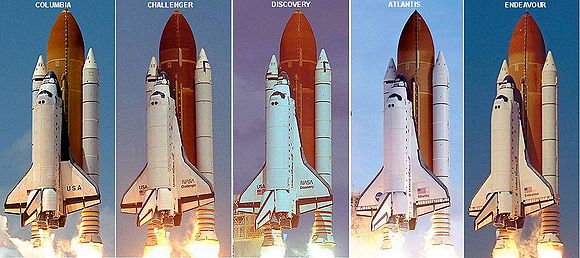 Shuttle launch profiles. From left to right: Columbia, Challenger, Discovery, Atlantis, and Endeavour.
Shuttle launch profiles. From left to right: Columbia, Challenger, Discovery, Atlantis, and Endeavour.
Individual Space Shuttle orbiters were named in honor of antique sailing ships of the navies of the world, and they are also numbered using the NASA Orbiter Vehicle Designation system. Three of the names had also been borne by Apollo spacecraft in 1969-1972: Apollo 11 command module Columbia, Apollo 15 command module Endeavour, and Apollo 17 lunar module Challenger.
While all of the Orbiters are externally practically identical, they have minor differences in their interiors. New equipment for the Orbiters was installed in the same order that they underwent maintenance work, and the newer Orbiters were constructed by Rockwell International, under NASA supervision, with some more advanced, lighter in weight, structural elements. Thus, the newer Orbiters, such as the Atlantis and the Endeavour, had slightly more cargo capacity than the others.
Test Articles Number Name Notes OV-095 - Shuttle Avionics Integration Laboratory, simulator for actual flight hardware and software system testing and training OV-098 (honorary) Pathfinder Orbiter Simulator for moving and handling tests. Currently on display at the U.S. Space & Rocket Center MPTA-098 - Testbed for propulsion and fuel delivery systems STA-099 - Structural test article used for stress and thermal testing, later became Challenger OV-101 Enterprise First atmospheric free flight August 12, 1977. Used for approach and landing tests, not suitable for spaceflight. Currently on display at the Steven F. Udvar-Hazy Center, slated to be relocated to the Intrepid Sea, Air & Space Museum[9] Orbiters Number Name Notes OV-099 Challenger First launched April 4, 1983. Destroyed after take-off on January 28, 1986 OV-102 Columbia First launched April 12, 1981. Destroyed during re-entry on February 1, 2003 OV-103 Discovery First launched on August 30, 1984. Will be placed on permanent display at the Steven F. Udvar-Hazy Center[9] OV-104 Atlantis First launched on October 3, 1985. Will be placed on permanent display at the Kennedy Space Center Visitor Complex[9] OV-105 Endeavour First launched on May 7, 1992. Will be placed on permanent display at the California Science Center[9]  Challenger while in service as structural test article STA-099.
Challenger while in service as structural test article STA-099.
- The Enterprise was a prototype designed to test Space Shuttle behavior in atmospheric flight. It is currently on display at the Smithsonian's National Air and Space Museum Steven F. Udvar-Hazy Center near Dulles International Airport.
- The Columbia first launched on April 12, 1981. On February 1, 2003, the Columbia burned and disintegrated during its re-entry during its 28th spaceflight.
- The Challenger first launched on April 4, 1983. On January 28, 1986 it disintegrated 73 seconds after launch on its 10th mission.
- The Discovery first launched on August 30, 1984. It flew 39 missions, and was NASA's Return to Flight vehicle, following the accidental destruction of the Challenger and the Columbia. The Discovery completed its last mission, STS-133, in March 2011. It is now retired and being decommissioned.[11]
- The Atlantis first launched on October 3, 1985. It flew 33 spaceflights including the final space shuttle mission, STS-135, in July 2011.
- The Endeavour first launched on May 7, 1992. It flew 25 spaceflights, the final being STS-134, launched May 16, 2011.
In addition to the test articles and orbiters produced for use in the Shuttle program, there are also various mock-ups on display throughout the world:
- Space Shuttle Explorer, a full-scale replica of an orbiter at the Kennedy Space Center visitor's complex
- Space Shuttle Adventure, a full-scale replica of an orbiter mid-deck and flight deck at Space Center Houston
- Space Shuttle America, a full-scale replica of a space shuttle for a theme park attraction since disassembled and removed
- Space Shuttle Pathfinder, an actual full-scale mock-up of the space shuttle originally built and used to test clearance and various ground operations; currently displayed at Space Camp in Huntsville, Alabama
Flight statistics
Shuttle Flights Flight days Orbits Longest flight First flight Last flight Mir/ISS
dockingSTS Launched STS Launched Columbia † 28 300d 17h 47m 15s 4,808 17d 15h 53m 18s STS-1 Apr 12, 1981 STS-107 † Jan 16, 2003 0 / 0 Challenger † 10 62d 07h 56m 15s 995 08d 05h 23m 33s STS-6 Apr 04, 1983 STS-51-L † Jan 28, 1986 0 / 0 Discovery 39 364d 22h 39m 29s 5,830 15d 02h 48m 08s STS-41-D Aug 30, 1984 STS-133 Feb 24, 2011 1 / 13 Atlantis 33 306d 14h 12m 43s 4,848 13d 20h 12m 44s STS-51-J Oct 03, 1985 STS-135 July 8, 2011 7 / 12 Endeavour 25 296d 03h 34m 02s 4,677 16d 15h 08m 48s STS-49 May 07, 1992 STS-134 May 16, 2011 1 / 12 Total 135 1330d 18h 9m 44s 21,158 9 / 37 † Destroyed

See also
- Shuttle Buran
- Shuttle SRB
- Spaceplane
- Spacecraft
References
- ^ "Facts About the Space Shuttles". NASA. http://www.nasa.gov/centers/kennedy/shuttleoperations/orbiters/orbiters_toc.html.
- ^ "HSF - The Shuttle". Spaceflight.nasa.gov. http://spaceflight.nasa.gov/shuttle/reference/shutref/orbiter/rcs/overview.html. Retrieved July 17, 2009.
- ^ "Orbital Maneuvering System". Science.ksc.nasa.gov. http://science.ksc.nasa.gov/shuttle/technology/sts-newsref/sts-oms.html#sts-oms. Retrieved July 17, 2009.
- ^ Kulkarni, Nilesh; Krishnakumar, Kalmaje. "Spacecraft guidance, navigation, and control requirements for an intelligent plug-n-play avionics (PAPA) architecture". American Institute of Aeronautics and Astronautics. NASA Ames Research Center. http://hdl.handle.net/2060/20060019188. Retrieved 19 October 2011.
- ^ "NASA Tech Briefs, September 1998". NASA Tech Briefs. NASA. http://hdl.handle.net/2060/20110003618. Retrieved 27 September 2011.
- ^ "STS-113 Space Shuttle Processing Questions & Answers (NASA KSC)". Ksc.nasa.gov. November 15, 2002. http://www.ksc.nasa.gov/nasadirect/archives/KSCDirect/archives/launch/sts113/day1/sspqa.htm. Retrieved July 17, 2009.
- ^ "www.kansascity.com". Web.archive.org. Archived from the original on January 17, 2008. http://web.archive.org/web/20080117121138/http://www.kansascity.com/105/story/441167-p4.html. Retrieved July 17, 2009.
- ^ "NASA - Space Shuttle Night Landings". NASA. http://www.nasa.gov/mission_pages/shuttle/launch/night_landings.html. Retrieved July 23, 2011.
- ^ a b c d e Weaver, David (April 12, 2011). "VNASA Announces New Homes For Shuttle Orbiters After Retirement". NASA. http://www.nasa.gov/home/hqnews/2011/apr/HQ_11-107_Orbiter_Disposition.html. Retrieved April 12, 2011.
- ^ http://klabs.org/DEI/Processor/shuttle/shuttle_tech_conf/1985008580.pdf
- ^ "Discovery Decommissioning Continues". Discovery RSS Archive. NASA. http://www.nasa.gov/mission_pages/shuttle/launch/discovery_rss_collection_archive_1.html. Retrieved 11 May 2011.
External links
NASA Space Shuttle (STS) Core topics 


Components Orbiter Vehicle (OV) · Solid Rocket Booster (SRB) · External Tank (ET) · Main Engine (SSME) ·
Orbital Maneuvering System (OMS) · Reaction control system (RCS) · Thermal protection system · Booster separation motorOrbiters Add-ons Sites Operations Missions (cancelled) · Crews · Mission timeline · rollbacks · Abort modes · Rendezvous pitch maneuverTesting Disasters Support Special Derivatives Related Space Shuttle design process · Inertial Upper Stage · Payload Assist Module · ISS · Space Shuttle retirement · Explorer (shuttle replica)Space Shuttles  United States Space Shuttle program
United States Space Shuttle program Soviet Buran program
Soviet Buran program- Pathfinder (OV-098, ground tests)
- Enterprise (OV-101, atmospheric tests, retired)
- Columbia (OV-102, destroyed 2003)
- Challenger (OV-099, destroyed 1986)
- Discovery (OV-103, retired)
- Atlantis (OV-104, retired)
- Endeavour (OV-105, retired)
Categories:- NASA space vehicles
- Space Shuttle program
- Delta-wing aircraft
- Hypersonic aircraft
- Glider aircraft
Wikimedia Foundation. 2010.

